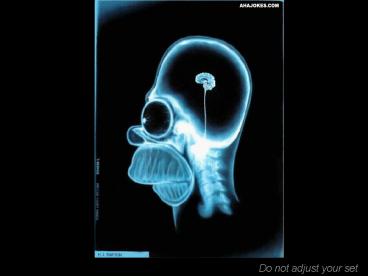General Radiation Safety PowerPoint PPT Presentation
1 / 35
Title: General Radiation Safety
1
Do not adjust your set
2
Radiation Safety in Medical Practice
- John Saunderson
- Radiation Protection Adviser
- (TPRH ext. 6690, john.saunderson_at_hey.nhs.uk)
3
Programme
- Introduction
- Radiation basics and hazards
- Organising radiation safety
- Any questions?
4
- Ionising radiations
- x-rays
- gamma rays (?-rays)
- beta particles (?)
- electron beams
- Not ionising radiations
- lasers
- ultraviolet (UV)
- infrared (IR)
- ultrasound
- MRI
5
Radiation basics and hazards
- Why is it dangerous?
- Radiation in hospitals
6
(No Transcript)
7
(No Transcript)
8
(No Transcript)
9
(No Transcript)
10
(No Transcript)
11
Ionising radiation can cause chemical reactions
in the bodys cells which may
- do no harm
- kill the cell
- cause the cell to multiply out of control
(cancer) - cause the cell to misfunction in some other way.
12
Where very large doses kill many cells
- radiation burns
- cateract
- radiation sickness.
13
Threshold risksVery large doses onlyThe bigger
the dose, the more severe the effect
Staff doses never this big
14
Cancer risksIt is assummed that any dose of
radiation could potentially cause cancer.The
bigger the dose, the more likely the effect will
occur, (but it will probably never occur).
i.e. a bit like crossing the road - the more
times you cross the more likely you are to be run
over, but probably never will.
15
Radiation in hospitals
- Radioactive substances
- nuclear medicine
- pathology
- radiotherapy
- X-ray sources
- Radiology
- Radiotherapy
- Pathology .
16
(No Transcript)
17
(No Transcript)
18
Scatter Dosee.g. Lat. Lumbar spine
- No lead apron 0.6 mGy _at_ 30 cm
- With 0.35 mm apron 0.06 mGy _at_ 30 cm
- Public dose limit 1 mSv ? 17 patients
- CC constraint 5 mSv ? 83 patients
- Staff limit 6 mSv ? 100 patients.
19
Doses Relative to Lum. Sp.
- Chest x 0.02
- Skull x 0.04
- Thoracic spine, pelvis x 0.5
- Abdomen x 0.8
- IVU x 1.5
- Ba. Enema x 4.1
- CT abdomen x 5.9.
20
All doses should be kept
- As
- Low
- As
- Reasonably
- Achievable
- The ALARA Principle .
21
Basic Principles
- Time
- Distance
- Shielding
22
Distance
- Double distance 1/4 dose
- Triple distance 1/9th dose.
23
Shielding
24
Shielding
25
Organising radiation safety
- Controlled Areas
- Local Rules
- Radiation Protection Supervisor
- Radiation Protection Adviser
- Radiographer .
26
IRMER
- Operators
- Training
27
f i n
28
Radiation Quantities and Units
- Dose
- e.g. skin dose
- Dose equivalent
- Effective dose
29
Absorbed Dose (D)
- Amount of energy absorbed per kg
- Measured in Grays (Gy)
- 1 Gy 1000 mGy (milligray)
- 1 mGy 1000 ?Gy (microgray)
- gt 2 Gy to skin causes erythema (sun burn)
30
Typical Values of D
- Radiotherapy dose 40 Gy to tumour (over several
weeks) - LD(50/30) 4 Gy to whole body (single dose)
- Annual background dose 2.5 mGy whole body
- Chest PA skin dose 160 uGy
- Mammo skin dose 9 mGy .
31
Dose Equivalent (H)
- Measured in Sieverts (Sv)
- 1 Sv 1000 mSv (millisievert)
- 1 mSv 1000 ?Sv (microsievert)
- Dose equivalent absorbed dose x Q
- Q depends on type of radiation
- For X-rays, Q 1, so 1 Sv 1 Gy
- Alpha rays are ten times as dangerous as X-rays,
so Q 10, so 10 Sv 1 Gy
32
Effective Dose (E)
Tissue or organ wT Gonads 0.20 Red bone
marrow 0.12 Colon 0.12 Lung 0.12 Stomach 0
.12 Bladder 0.05 Breast 0.05 Liver 0.05 Oe
sphagus 0.05 Thyroid 0.05 Skin 0.01 Bone
surfaces 0.01 Remainder 0.05
- Sum of equivalent doses to each tissue/organ x
organ weighting factors E ?T wT.HT - Units are Sieverts (Sv)
- Risk of cancer is proportional to effective dose
e.g. if breast alone received 2 mGy to tissue, E
0.05 x 2 0.1 mSv.
33
Typical Values of E
- Barium enema 7 mSv
- CT abdomen 10 mSv
- Conventional abdomen 1 mSv
- Chest PA 20 uSv
- Annual dose limit for radiation workers 20 mSv
- Annual background dose 2.5 mSv .
34
Old Units
- 100 rad 1 Gy 100cGy
- 100 rem 1 Sv
- 100 R ? 0.9 Gy
35
ICRP System of Radiological Protection
- Justification
- no unnecessary exposures
- Optimisation
- keep doses as low as reasonably achievable
(ALARA) - Limitation
- dose limits for workers and staff
- diagnostic reference levels (DRL) for patients
- DRL for mammo. 2 mGy glandular dose .

